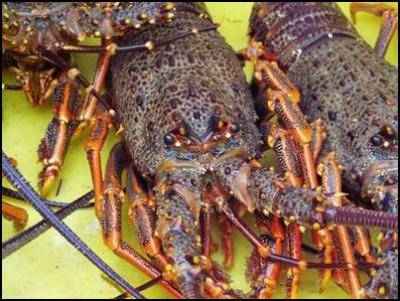Research to enable better management of rock lobster
MEDIA RELEASE
20 August, 2013
Research to enable better management of rock lobster fisheries
The seafood industry is boosting investment in Victoria University research that uses state-of-the-art genetic profiling to ensure continued sustainable management of New Zealand’s lucrative rock lobster fisheries.
The New Zealand Rock Lobster Industry Council and Seafood Innovations Limited will jointly fund a two-year research project at Victoria’s School of Biological Sciences, led by Senior Lecturer Dr James Bell, which has potential to improve stock management and significantly increase export earnings from the industry.
Dr Bell and a PhD student, Irina Ilyushkina, will be examining the genetic make-up of rock lobster populations around the New Zealand coastline and using this information to identify patterns of larval movement.
The work will support improved assessment and monitoring of rock lobster stocks and help to ensure the industry meets the highest food safety and traceability standards.
Commonly called crayfish, the red rock lobster (Jasus edwardsii) is New Zealand’s most valuable inshore fishery export, worth over $220 million in export earnings each year.
Victoria University researchers have previously partnered with the rock lobster industry, using DNA technology to increase understanding of the sources of lobster larvae and movement of larvae between populations in New Zealand and Australia. This research was recently published in the international journal Heredity.
Dr Bell says the new research project, which starts in September, will have a range of potential benefits for the industry, including producing accurate information on the patterns of larval exchange between populations as well as identifying populations that are net producers of larvae. The study is one of the most extensive genetic studies of a single New Zealand marine species ever undertaken.
“We hope to identify populations of rock lobsters that are genetically distinct. By looking at their genetic make-up and the barriers to larval movement, such as ocean currents, we aim to identify populations that are self-recruiting, meaning the larvae produced by a population return to the same population to live as adults.”
Dr Bell says this information could open up niche marketing opportunities for the industry.
“Consumers may well be prepared to pay a premium for a rock lobster that they know was born and bred in a particular area such as, for example, around Stewart Island, Fiordland and the West Coast.”
Other potential benefits include improved traceability says Dr Bell.
“Understanding the genetic make-up of the different rock lobster populations around New Zealand means we will have a good idea where a particular lobster comes from should we ever need this information for food safety traceability.”
Further down the track, the research may also support ‘ranching’ of wild juvenile rock lobsters where larvae are shifted to better quality habitat, where they have a better chance of survival.
Daryl Sykes, Executive Officer of the New Zealand Rock Lobster Industry Council, says the new research project is a great foundation for ongoing collaboration with Victoria University to improve both management of the rock lobster fishery and economic performance by the industry.
“Our intention is to actively manage lobster populations through their complete life cycle—larvae to adult—increasing the important social, cultural and economic benefits to New Zealand.”

ENDS


 University of Canterbury: Research Sheds Light On Fire Risk For Canterbury
University of Canterbury: Research Sheds Light On Fire Risk For Canterbury GE Free NZ: Potential $20 Billion Loss In Export Demand Threatens Rural Communities
GE Free NZ: Potential $20 Billion Loss In Export Demand Threatens Rural Communities Science Media Centre: Carbon-storing Construction Materials – Expert Reaction
Science Media Centre: Carbon-storing Construction Materials – Expert Reaction Vegetables New Zealand: New Web-Based Tool Will Help Greenhouse Growers Switch To Geothermal Heating
Vegetables New Zealand: New Web-Based Tool Will Help Greenhouse Growers Switch To Geothermal Heating Horizon Research Limited: New Poll - New Zealanders Prefer Rail Enabled Ferries
Horizon Research Limited: New Poll - New Zealanders Prefer Rail Enabled Ferries Watercare: Watercare Gets To Work On First Permanent Non-Potable Water Tanker Filling Station In Māngere
Watercare: Watercare Gets To Work On First Permanent Non-Potable Water Tanker Filling Station In Māngere



